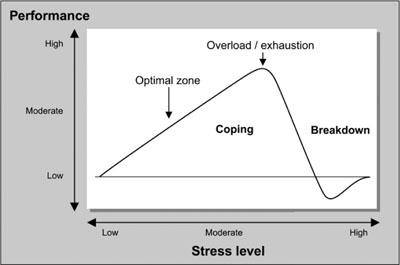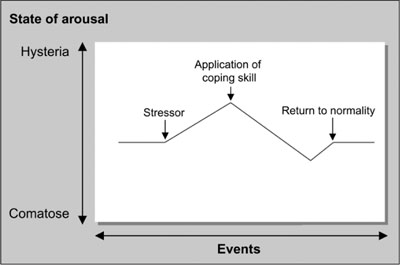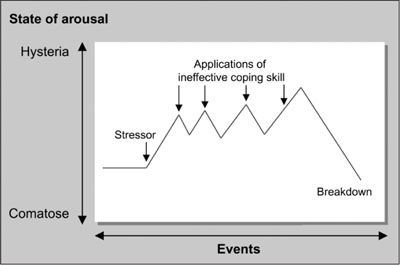Chapter 9
Stress avoidance
Carole Brennan
Aim
The aim of this chapter is to help in identifying and coping with stress, primarily in the workplace.
Outcome
After reading this chapter, readers should have a better understanding of how stress can affect general health and well-being, as well as performance at work. Readers should also have more awareness of the actions that can be taken to develop or adopt appropriate coping strategies.
What is stress?
Stress is different things to different people: to the Olympic athlete, it is the challenge of competing and pushing physical abilities to the limit; to the student, it can be the pressure of examinations; to the leader of the dental team, it may be running the practice; and to the employee, it can be dealing with the boss who is never satisfied. Alternatively, stress may be considered to be the ‘wear and tear’ our bodies experience as we adjust to our continually changing environment and cope with the many, varied demands of modern society.
We tend to consider stress as harmful, but some stress is good for you, possibly even necessary. While some stress may be good, too much can be detrimental. Too much negative stress results in distress. Negative stress is the stress of losing, failing, overworking, being criticised or generally not coping.
Unfortunately, we all experience negative stress from time to time, and if an individual becomes too stressed their performance suffers. It is impossible to avoid all stress. The only stress-free state is death! The key is to learn how to position yourself at or around the optimal point on the performance–stress graph (Fig 9-1), so that you are coping and performing well and avoiding being stressed to the extent that you are not able to meet aims and objectives, let alone risk suffering a breakdown.

Fig 9-1 Illustration of relationship between performance and level of stress
The optimal point on the performance–stress graph varies from individual to individual, and for any one individual from time to time. Some individuals thrive on high-performance/high-stress working, while others have a much lower performance and stress-related capacity. Under certain conditions, some individuals may suffer an exaggerated reaction, showing disproportionate levels of stress, even at low levels of performance.
Stress at work
Most people have to work and, as a consequence will experience some work-related stress. Some are lucky enough to work in jobs of their choosing and that they enjoy, but others have to work in jobs and in conditions which are not of their choosing and with little, if any, job satisfaction. Whichever situation, there will be periods when an individual may be unhappy, or at least unsettled at work and stressed.
Work-related stress is a major health concern around the world: across all sectors and in all sizes of enterprises. Stress-related breakdown and suicide rates amongst dental healthcare professionals, in particular dental practitioners, are high compared with some other professions, with stress overload being identified as a major contributing factor.
It makes good sense, therefore, to be able to understand what stresses you personally are working under, to be able to recognise when you are distressed and, most importantly, to understand what actions you can take to reduce or control your stress levels.
Understanding stress and its affects
Understanding the process of stress and how it affects you makes it easier to identify your major sources of stress, to know which feelings and reactions indicate your response to stress, and to enable you to anticipate and plan for stressful events or periods.
It does not always follow that moderate to high levels of stress will compromise performance and that stressed people will succumb to physical and psychological ill-health. Stress, however, has been associated with a number of conditions, including high blood pressure, stroke, ulcers, coronary heart disease, asthma, diabetes, cancer and psychiatric disorders such as depression and anxiety (panic) states.
Performance–stress homeostasis describes a state of balance in which the body function efficiently and comfortably. Enhanced stress disturbs this homeostasis by creating an imbalance. It is the ability to cope with stressors that determines the amount of stress that is experienced, and the method of coping with stress that determines whether this stress is damaging (Figs 9-2 and 9-3).

Fig 9-2 Healthy stress reaction.

Fig 9-3 Atypical stress reaction.
Most active people prefer to live with a moderate level of arousal and associated stress. Under normal circumstances, a stressor will increase the level of arousal and stress. Sensing this change, the normal reaction is the application of an appropriate coping skill, which may be effective to the extent that it causes the level of arousal and stress to drop below the normal level prior to returning to normal (Fig 9-3). Alternatively, a stressor may trigger an ineffective coping skill or skills, causing the level of arousal and associated stress to peak above, or repeatedly exceed, normal levels, leading eventually to fatigue and breakdown.
The fight or flight response
The fight or flight response is a physiological reaction that prepares the body to respond to an emergency (Fig 9-4). Our distant ancestors needed such reactions to survive the dangers of everyday living. In present circumstances, the fight for flight reaction is still important, but is not normally a matter of life or death.

Fig 9-4 The fight or flight response.
This fight or flight response worked perfectly for our ancestors’ lifestyle, but today’s lifestyle is very different. We live in a fast moving, high-technology world that has evolved considerably faster than we have. Stressors ‘threaten us’ in every aspect of our lives. Compared with our ancestors, we have to deal with many more stressors and be able to deal with several stressors at the same time. Yet we have only the primitive fight or flight response with which to cope.
Confronted with significant stressors, the body changes, shifting gear into high physiological arousal to enable the fight or flight response to take place. The various processes that take place during the fight or flight response are well documented elsewhere. Following management of the stressor, it takes the body some time to return to the normal state of arousal and associated stress. Reactions that can be associated with this return to normality may include relief, irritability, anxiety, depression or even anger, one or more of which may trigger further stress.
The general adaptation syndrome
If the fight or flight response is constantly being triggered, the body never gets the chance to return to normal and, therefore, remains in a constant state of high arousal with associated stress. This has long-term detrimental effects on our physical and mental health.
Selye, a pioneer in stress research, proposed in 1946 a three-stage process in prolonged stress management, referred to as the general adaptation syndrome. If left untreated, this syndrome predisposes people to various conditions and illnesses.
The sequence runs as follows.
→ Stage 1: alarm reaction. Any physical or mental trauma will trigger an immediate set of reactions to stress, such as raised blood pressure and a dry mouth. The immune system is also suppressed and normal levels of resistance are lowered. If the stress is not severe or prolonged, recovery is rapid and, as a consequence, the susceptibility to stress-related conditions is short lived.
→ Stage 2: resistance. With repeated exposure to stressors, there is a substantial degree of adaptation. The modified reaction to stress triggers imposes extra demands on the body, which is progressively drained of energy resources and resistance to stress-related disorders and diseases. The individual may become complacent about the high-stress situation, assuming that the body can resist the effects of stress indefinitely. Therein lies the danger: believing in immunity to the effects of stress, and possibly even demanding more of the body, makes an individual increasingly vulnerable to stress-related conditions and illnesses.
→ Stage 3: exhaustion. When the body is no longer able to maintain homeostasis and the processes needed to combat stress, there is a sudden fall in the capacity to manage stress, and resistance levels fall. Eventually stress-fighting reserves finally succumb to what Seyle called ‘disease adaptation’. In this state, an individual is very vulnerable to stress-related conditions and illnesses.
Signs and symptoms of stress
If some stress is beneficial, how can a person assess if the level of stress they are experiencing is good for them. One of the problems associated with stress is impaired judgement, which blinds us to how well we are controlling and coping with />
Stay updated, free dental videos. Join our Telegram channel

VIDEdental - Online dental courses


